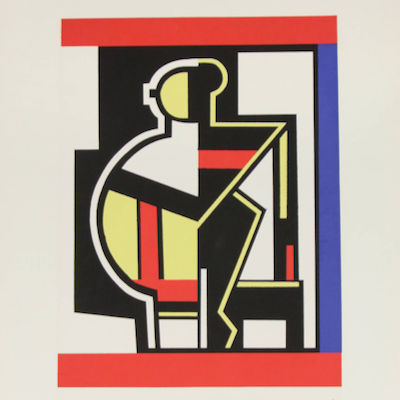
Details
Artist
Styles
Etching and aquatint in colours, on BFK Rives paper, with full margins. - This work is from the UNITÉ book, which began to be printed in 1963 and ended on October 15, 1965 in Paris. - I. 41.5 x 31.5 cm (16 3/8 x 12 3/8 in.) - S. 57 x 45.2 cm (22 1/2 x 17 3/4 in.) - Signed and numbered in pencil, from the edition of 130 pc + 30 in Roman numerals, published by Atelier Crommelynck, Paris // Le Corbusier’s Unité 20 (1963-1965) is a limited-edition etching and aquatint in color, printed on BFK Rives paper. The artwork belongs to the UNITÉ book, created between 1963 and 1965. This piece exemplifies Le Corbusier's signature blend of abstract forms and architectural lines. The central figure features a fragmented human form, rendered in a combination of bold black lines and vibrant color blocks. The geometric shapes, textured patterns, and layered lines evoke a sense of both structure and organic flow, while the red and brown backgrounds ground the abstract figure. The limited palette enhances the composition's modernist aesthetic, reflecting Le Corbusier's vision of the human form within urban and architectural spaces.
Unité 20, 1963-1965
form
Medium
Size
57 x 45.2 cm
- Inches
- Centimeters
Edition
Price
- USD
- EUR
- GBP
Details
Artist
Styles
Etching and aquatint in colours, on BFK Rives paper, with full margins. - This work is from the UNITÉ book, which began to be printed in 1963 and ended on October 15, 1965 in Paris. - I. 41.5 x 31.5 cm (16 3/8 x 12 3/8 in.) - S. 57 x 45.2 cm (22 1/2 x 17 3/4 in.) - Signed and numbered in pencil, from the edition of 130 pc + 30 in Roman numerals, published by Atelier Crommelynck, Paris // Le Corbusier’s Unité 20 (1963-1965) is a limited-edition etching and aquatint in color, printed on BFK Rives paper. The artwork belongs to the UNITÉ book, created between 1963 and 1965. This piece exemplifies Le Corbusier's signature blend of abstract forms and architectural lines. The central figure features a fragmented human form, rendered in a combination of bold black lines and vibrant color blocks. The geometric shapes, textured patterns, and layered lines evoke a sense of both structure and organic flow, while the red and brown backgrounds ground the abstract figure. The limited palette enhances the composition's modernist aesthetic, reflecting Le Corbusier's vision of the human form within urban and architectural spaces.
- Recently Added
- Price (low-high )
- Price (high-low )
- Year (low-high )
- Year (high-low )
What is Cubism?
Cubism is an art movement that aimed to depict multiple perspectives of objects or figures within a single picture. Artists Georges Braque and Pablo Picasso pioneered this style around 1907. The name Cubism emerged from their use of geometric shapes and outlines that often resembled cubes, breaking objects down into abstracted forms.



























